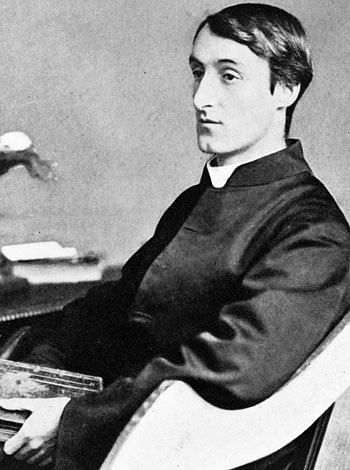How does inscape relate to landscape? For Gerard Manley Hopkins, inscape was that which gives something its own special identity. We come to feel and perceive these qualities through what he called instress. J.R. Watson: ‘the inscape of an elm tree is the property by which we recognize it: but it is not just its shape or ‘scape’: it is its ‘inscape’, its inner being or self-hood, the thing itself in its own special nature.’
However, inscape is not necessarily about the qualities of a particular tree. For example, on May 18 1870, Hopkins noted in his diary “great brilliancy and projection: the eye seemed to fall perpendicular from level to level along our trees, the nearer and further Park; all things hitting the sense with double but direct instress.” Here the instress is a force from within the trees which gives this landscape its particular intensity.
W. H. Gardner describes instress as ‘the sensation of inscape – a quasi-mystical illumination, a sudden perception of the deeper pattern, order and unity which gives meaning to external forms.’ Hopkins experienced instress as he walked in the landscape, studying bluebells and horned violets, looking at the moon and the sky or the waves of the sea, even, as here, in encountering an old stone pointed arch:
'The day was bright, the sun sparkling through a frostfog which made the distance dim and the stack of Denbigh hill, as we came near, dead mealy grey against the light: the castle ruins, which crown the hill, were punched out in arches and half arches by bright breaks and eyelets of daylight. We went up to the castle but not in: standing before the gateway I had an instress which only the true old work gives from the strong and noble inscape of the pointed arch...'
- from Gerard Manley Hopkins’ diary, February 4th 1875

5 comments:
your blog seems to be so interesting. I'm architecte, i love landscape and landart. I try to understand english. As to me landscape is a humain representation of nature, environement (nztural znd human). Landscape is juste a point of view which can change just turning the head left or right. We can manipulate landscape. In art, landscape is the human expression of his presence in the world.
thanks for this blog
You suggest that Gerard Manley Hopkins ultimately perceived the qualities of inscape through his experience of instress. I have always understood that he perceived inscape first, when the observer is concentrating all his senses on a unique and distinctive object and is in full harmony with it . Then, at that precise moment, the observer starts to experience the unifying force from within the object. This force, a surge of feeling, an understanding, an excitement over the revelation, is the instress. Hopkins believed instress was the revelation of God.
Jerome Bump analysed sketches of Freshwater Bay, IOW, made by Gerard Manley Hopkins and his brother, Arthur, in 1863 (‘All my eyes see: Visual world of Gerard Manley Hopkins’ edited by R K R Thornton, 1975) and suggested that, whilst Arthur’s ‘Arched Rock, Freshwater Bay’ illustrated the meaning of inscape, Gerard’s ‘Study from the cliff above, Freshwater Gate’ tried to capture instress. Manley Hopkins wrote in his journal: ‘Note: The curves of the returning wave overlap, the angular space between is smooth but covered with a network of foam. The advancing wave, already broken, and now only a mass of foam, upon the point of encountering the reflux of the former.‘ Jerome Bump commented that Gerard lost interest in what was merely unique; as in the wave study he usually sought the distinctively unifying design, the "returning" or recurrent pattern, the internal "network" of structural relationships which clearly and unmistakably integrates or scapes an object or set of objects and thus reveals the presence of integrating laws throughout nature and a divine unifying force or "stress" in this world. The suggestion of metaphysical significance is obvious in an 1874 note by Hopkins on waves: "The laps of running foam striking the sea-wall double on themselves and return in nearly the same order and shape in which they came. This is mechanical reflection and is the same as optical: indeed all nature is mechanical, but then it is not seen that mechanics contain that which is beyond mechanics." .
Thanks Emmanuel.
Thanks Aureliaray: Do you have a quote to illustrate this two stage process?
Even the experience of inscape wasn't open to everyone. GMH wrote in his journal: "I thought how sadly beauty of inscape was unknown and buried away from simple people and yet how near at hand it was if they had eyes to see it and it could be called out everywhere again."
this is jo, from the blog inscape, http://landscape.blogspot.com, just wanting to say how much i'm enjoying your writing on this underexplored zone of psychology, landscape, and production. i'd be interested in corresponding further about these or related topics. i also run a number of landscape studies events with other scholars whose work you might enjoy. please say hello!
Thanks Jo - looks like your blog is in abeyance? I liked the post on esoteric landscape books.
Post a Comment